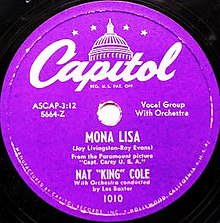Mona Lisa (song)
Mona Lisa is the title of a pop song made famous by Nat King Cole in 1950, which has become an evergreen thanks to numerous cover versions .
History of origin
The original was not made by Nat King Cole, however. It was first presented - albeit fragmentarily - in the movie Captain Carey, USA , which was released on February 21, 1950. The shooting for this began on February 14, 1949 and lasted until the end of March 1949, some corrections were made on April 5, 1949. The famous film music authors Jay Livingston and Raymond B. Evans have Mona Lisa composed for this film.
Jay Livingston described the unusual genesis of the song in an interview. A suitable song had to be found for a film set in Italy during the Second World War with the working title OSS , which a blind accordion player (played by David Leonard) would play on the street whenever he warned compatriots about a German soldier patrol had to. The authors wrote Mona Lisa for this because it sounded very Italian. However, the film title was then changed to After Midnight , and the music title should also be adjusted at the request of the production. Therefore the authors wrote a new text and wrote After Midnight . A month later they read in the star magazine Variety that the new film would now be called Captain Carey, USA . The authors wanted to use the Mona Lisa again and this also convinced the film production. The piece, whose text compares a woman with the mystical smile of the famous painting, won an Oscar for best movie song. This was the first time for a film that is not based on a film adaptation of a musical .
Record recordings
The first commercial recording comes from the Charlie Spivak Orchestra with singer Tommy Lynn, who recorded the title three weeks before the film premiere on January 30, 1950. After its release in July 1950, the original made it to 16th place on the pop hit parade . This was followed by the Harry James Orchestra (singer: Dick Williams) with its recording of March 2, 1950, the version of which was published in August 1950 in 14th place.
Nat King Cole had an orchestra conducted by Les Baxter accompany him in his version . The Mona Lisa was recorded on March 11, 1950 with an arrangement by Nelson Riddle and released in May 1950. The romantic ballad reached the first rank, which it held for 8 weeks, and was performed more than 2 million times. Jazz pianist Cole established his reputation as an interpreter of romantic ballads with Mona Lisa with his sonorous bass voice .
The next recording came from the orchestra Victor Young with Don Cherry , who recorded their version in May 1950 and were able to advance to number 7. A total of 7 versions made it onto the charts in 1950, as well as from Art Lund, Ralph Flanagan and Dennis Day.
Carl Mann recorded a rockabilly version of Mona Lisa with his band on Sun Records in January 1959 , produced by Sun Promotion Manager Cecil Scaife. Label boss Sam Phillips was not convinced of this, however: “We are not releasing a mediocre product.” When country singer Conway Twitty heard of Mann's version, he was enthusiastic about the arrangement and recorded his own version on February 18, 1959 in Nashville under Jim Vienneau. Then Phillips decided to publish Mann's version on March 15, 1959; it reached number 25 on the pop charts, while Conway Twitty's version came on July 6, 1959 and came to number 29.
More cover versions and statistics
As early as December 1950, Fred Weyrich brought out a German version written by Kurt Feltz (B-side by Serenate Celesta ; Amiga # 1295), which he always sings on the edge of the sentimental. Detlev Lais and Gerhard Wendland followed in 1951. The elderly Sonny Rollins and his quartet were in the studio on October 7, 1995 in New York and immortalized the classic Mona Lisa . ASCAP has registered around 90 versions of this. For the two authors who specialize in film music , 519 (for Evans) and 528 compositions (for Livingston) are protected by copyright.
Individual evidence
- ↑ American Songwriter Magazine, July / August 1988 issue
- ^ The US Office of Strategic Services was responsible for sabotage operations in enemy territory and was the forerunner of today's CIA
- ^ Joseph Murrells, Million Selling Records , 1985, p. 62
- ↑ Colin Escott / Martin Hawkins: Good Rockin 'Tonight - Sun Records and the Birth of Rock'n Roll , 1992, p. 212
- ↑ Die Bunte Platte No. 4/1951, p. 10
- ↑ ASCAP entry for Mona Lisa

